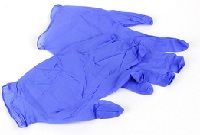FDA to Ban Powdered Gloves
Powders used to make it easier to put on surgical gloves can cause asthma in patients and doctors. They can result in adhesions and even tumors in surgical patients. The dangers have been known for years and alternative products are available.

Powdered medical gloves are a health hazard, the US Food and Drug Administration (FDA) says.
After 20 years of examining research reports showing the dangers involved in contact with the powder, the FDA today announced it is moving forward with plans to ban the product.
The ban would apply to powdered surgeon’s gloves, powdered patient exam gloves and to absorbable powder for lubricating a surgeon’s glove.
“This ban is about protecting patients and health care professionals from a danger they might not even be aware of,” said Jeffrey Shuren, MD, director of the FDA’s Center for Devices and Radiological Health.
The powder used on latex gloves—but not on synthetic gloves—can carry proteins that trigger allergic reactions. They are also “associated with an extensive list of potentially serious adverse events, including severe airway inflammation, wound inflammation, and post-surgical adhesion,” the FDA said.
Historically, the gloves have been powdered with talc (leading to development of granulomas in some patients when exposed during surgery), or with cornstarch, or with silicone. The FDA’s 1997 report on glove powder is here.
The agency said today it had completed an economic analysis that shows that removing the gloves from the marketplace would not cause a shortage because alternative products are widely available.
The FDA did not directly address the question of powdered gloves sold directly to the public but said the ban “would ultimately remove them from the marketplace completely.”
The FDA’s proposed rule is available online at www.regulations.gov for public comment for 90 days.
Banning the gloves has been a consideration for decades, as research showing the consequences mounted. Some of those studies are in the citations below:
.Malinger G, Ginath S, Zeidel L, Avinoach I, Katz R, Greenberg N, Zakut H, Sadan O Starch peritonitis outbreak after introduction of a new brand of starch powdered latex gloves Acta Obstet Gynecol Scand 79, 610-611 2000
.Nafeh AI, Nosseir M Assessement of peritoneal adhesions due to starch granules of surgical glove powder an experimental study J Egypt Soc Parasitol 37(3) 835-842 2007
.Numanoglu V, Cihan A, Salman B, Ucan BH, Cakmak GK, Cesur A, Balgaloglu H, Ilhanm MN Comparison between powdered gloves, powder-free gloves and hyaluronate/carboxymethylcellulose membrane on adhesion formation in a rat caecal serosal abrasion model Asian J Surg 30(2) 96-101 2006
.Odum BC, O'Keefe JS, Lara W, Rodeheaver RT, Edlich RF Influence of Absorbable Dusting Powder on Wound Infection J Emerg Med 16(6) 875-879 1998
Reddy VR, Thomas TS, Wright HR, Fisher MD, Edlich RF The Scientific Basis of Surgical Glove Selection in an In Vitro Fertilization Laboratory J Biomed Mat Res (Appl Biomater) 48, 569-571 1998
.Saary MJ, Kanani A, Alghadeer H, Holness DL, Tarlo SM Changes in rates of natural rubber latex sensitivity among dental school students and staff members after changes in latex gloves J Allergy Clin Immunol 109, 131-135 2002
.Sjosten ACE, Ellis H, Edelstam GAB Retrograde migration of glove powder in the human female gemota; tract Human Reproduct. 19(4) 991-995 2004.